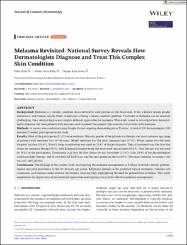| dc.contributor.author | Hızlı, Pelin | |
| dc.contributor.author | Kılıç, Fatma Arzu | |
| dc.contributor.author | Aytaç, Şeyma İçöz | |
| dc.date.accessioned | 2025-01-02T10:28:59Z | |
| dc.date.available | 2025-01-02T10:28:59Z | |
| dc.date.issued | 2024 | en_US |
| dc.identifier.issn | 1473-2130 / 1473-2165 | |
| dc.identifier.uri | https://doi.org/10.1111/jocd.16630 | |
| dc.identifier.uri | https://hdl.handle.net/20.500.12462/15642 | |
| dc.description.abstract | BackgroundMelasma is a chronic condition characterized by dark patches on the facial skin. It has a known female gender dominancy, and women usually think of melasma as being a serious cosmetic problem. Treatment of melasma can be seriously challenging, thus, dermatologists may employ different approaches for melasma. This study aimed to investigate how dermatologists diagnose and treat patients with melasma and to present the general characteristics of patients with melasma.MethodsA survey was conducted using Google Forms targeting dermatologists in Turkiye. A total of 199 dermatologists (142 females/57 males) participated in the study.ResultsMost of the participants (52.3%) were residents. Majority gender of the patients was female and most common age range of patients with melasma was 30-40 years. Mixed melasma was the most common type (57.4%). Malar region was the most frequent location (58.6%). Wood's lamp examination was used by 25.6% of the participants. Topical treatment was the first-line choice for melasma therapy (95%), with Kligman's formula being the most used topical agent (69.8%). Oral therapy was not used by 70.8% of the participants. Tranexamic acid was the first choice for oral treatment (23.4%). Only 24.9% of the dermatologists used laser/light therapy, and Q-switched Nd-YAG laser was the most preferred device (58%). The most common recurrence rate was 41%-60% (45.9%).ConclusionsThe findings of the current study investigating the melasma management in Turkiye revealed a female predominance and peak prevalence in the 30-40 years age group. Kligman's formula is the preferred topical treatment, whereas oral tranexamic acid remains underutilized. Recurrence rates are high, highlighting the need for preventative strategies. This study emphasizes the importance of personalized approaches and ongoing research for effective melasma management. | en_US |
| dc.language.iso | eng | en_US |
| dc.publisher | John Wiley and Sons Inc | en_US |
| dc.relation.isversionof | 10.1111/jocd.16630 | en_US |
| dc.rights | info:eu-repo/semantics/openAccess | en_US |
| dc.rights.uri | http://creativecommons.org/licenses/by/3.0/us/ | * |
| dc.subject | Chemical Peeling | en_US |
| dc.subject | Dermatologist | en_US |
| dc.subject | Laser | en_US |
| dc.subject | Melasma | en_US |
| dc.subject | Tranexamic Acid | en_US |
| dc.title | Melasma revisited: National survey reveals how dermatologists diagnose and treat this complex skin condition | en_US |
| dc.type | article | en_US |
| dc.relation.journal | Journal of Cosmetic Dermatology | en_US |
| dc.contributor.department | Tıp Fakültesi | en_US |
| dc.contributor.authorID | 0000-0001-8919-3125 | en_US |
| dc.contributor.authorID | 0000-0003-2983-065X | en_US |
| dc.contributor.authorID | 0000-0003-2939-8801 | en_US |
| dc.identifier.volume | 2024 | en_US |
| dc.identifier.issue | October | en_US |
| dc.identifier.startpage | 1 | en_US |
| dc.identifier.endpage | 6 | en_US |
| dc.relation.publicationcategory | Makale - Uluslararası Hakemli Dergi - Kurum Öğretim Elemanı | en_US |




















